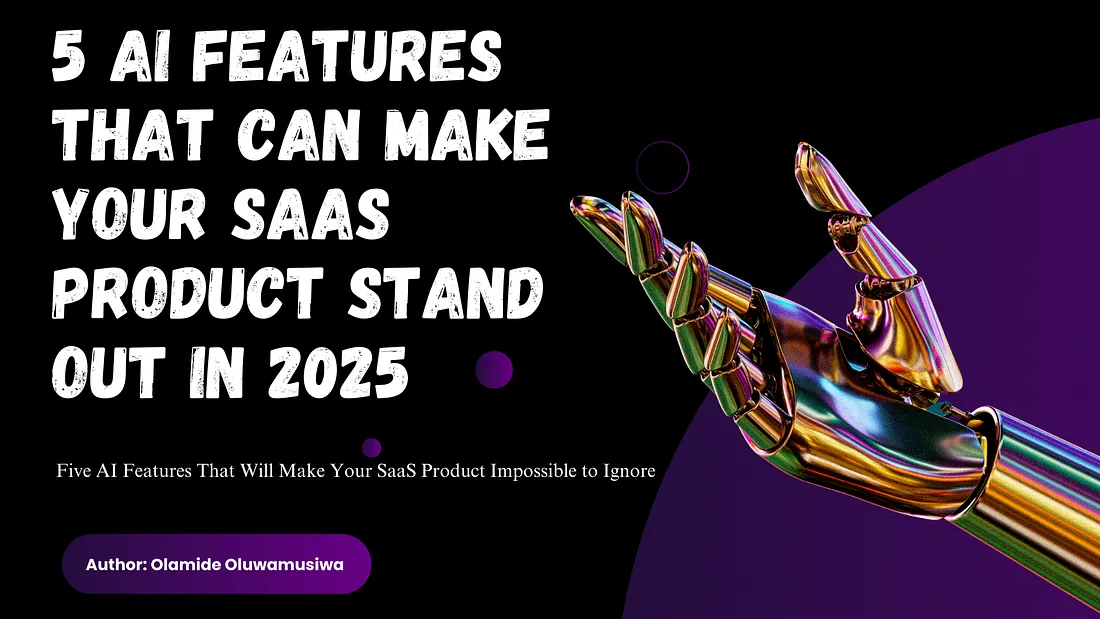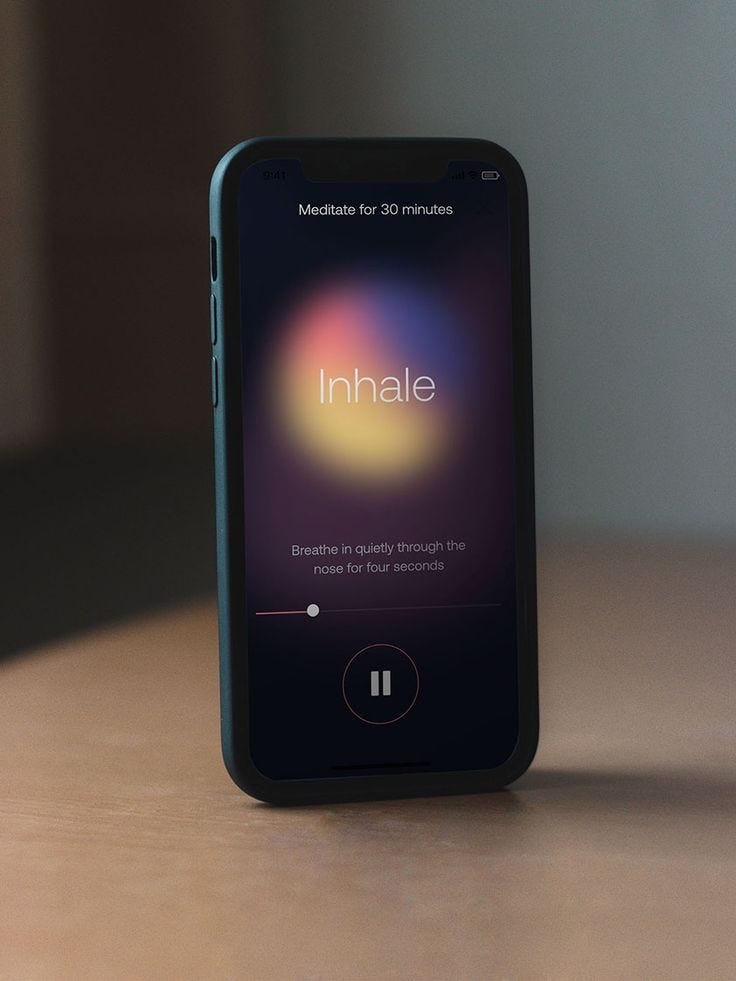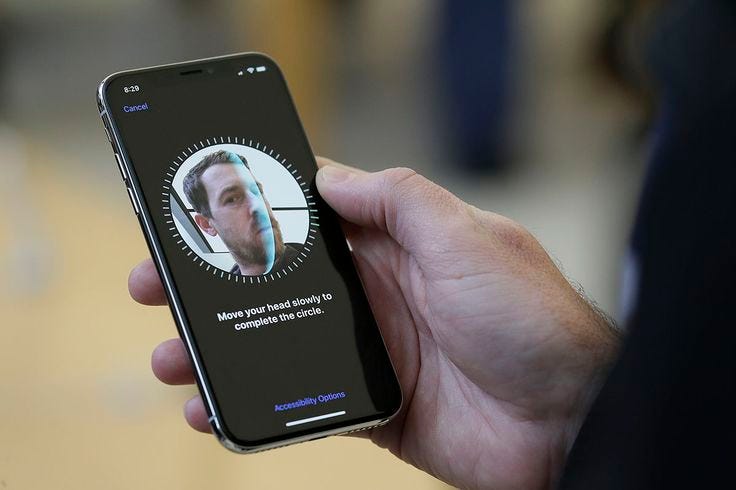5 AI Features That Can Make Your SaaS Product Stand Out In 2025
 Olamide David Oluwamusiwa
Olamide David Oluwamusiwa
AI isn’t optional anymore — it’s a must for SaaS products that want to win big. This piece walks through five game-changing AI features that make users happy, save time, and beat rivals. With real examples, numbers, and smart tips, you’ll see how AI lifts your SaaS above the pack.
Prerequisites
To get this, you should know:
How SaaS works — think subscriptions and keeping users.
A bit about AI and how it learns — like simple math that gets smarter.
What APIs are — how apps connect and share info.
Table of Contents
Introduction
Personal Touch with AI
Smart Automation & Workflow Fixes
Guessing Ahead & Smart Choices
Talking Like a Person (NLP)
AI for Safety & Fraud Stops
Conclusion & Next Steps
References
Introduction
AI isn’t just talk — it’s what makes SaaS winners stand out. A 2023 Gartner report says by 2030, AI-run SaaS tools will own 80% of the business software game. Look at Netflix suggesting shows or Grammarly catching your typos. These don’t just help — they guess what you need, speed things up, and feel made for you. SaaS is the same deal. This article hits five AI features that make your product shine, with real stories, good practices, and ways to make it happen.
1. AI Powered Personalization
The Problem It Fixes:
Users ditch tools that feel boring. No personal touch means they lose interest and quit. People want stuff that fits them perfectly now.
Why It’s a Big Deal:
A McKinsey report says personal experiences can grow your money by 10–30%. AI watches what users do and guesses what they’ll want next. That keeps them hooked, sticking around, and spending more over time.
How to Do It:
Straight-Up Personal: Users pick what they like — like choosing action movies on a streaming app.
Sneaky Personal: AI learns from clicks, searches, and past moves to tweak suggestions on its own.
Real Examples:
Netflix & Spotify: Netflix digs into what you’ve watched with fancy math and deep learning, then picks shows you’ll love. It cuts users leaving. Spotify’s Discover Weekly builds playlists from what you listen to and what others like you enjoy.
Amazon: Its AI suggestion system makes 35% of its cash by showing you stuff based on what you’ve looked at, bought, or what similar folks grab. It turns browsers into buyers.
Sephora: This beauty shop uses AI on its app and site to suggest products based on your skin, past buys, and hot trends. More people buy and stick around.
Duolingo: The language app tweaks lessons to match how fast you learn or where you mess up. More users finish courses and keep going.
YouTube: Its AI picks videos just for you — 70% of what people watch comes from those suggestions. More watch time, more ads, more loyalty.
Shopify: It helps store owners push products, deals, and prices based on what customers do. Engagement’s up 20% for those sellers.
Grammarly: It tweaks writing tips to fit your style or job, making you faster with smart fixes.

A personalized Netflix Recommendation screen suggestion based on a movie watched
How It Helps You Work Better:
Keeps users coming back with stuff they like, cutting drop-offs.
Grows cash with more sales, repeat buyers, and bigger orders.
Shows the right stuff fast, so users don’t get tired picking.
Cuts hand-work — AI handles suggestions, so you can grow easy.
Makes support better — chatbots use user past to answer quick, dropping tickets.
Smart Tips:
Track user moves live for fresh personal tweaks.
Test two versions to make AI guesses sharper.
Keep it light but useful — don’t swamp users.
Watch Out:
Too much personal can feel nosy — let users steer a bit.
Weak AI training means dumb suggestions that annoy instead of help.
2. Smart Automation & Workflow Fixes
The Problem It Fixes:
Repeat jobs slow you down, cost more, and stop growth. Workers waste hours on small stuff like data entry or okaying things, leaving less time for big wins.
Why It’s a Big Deal:
AI takes over workflows, keeping things right with less human fuss. Deloitte says it can cut costs 30–50%, speed things up, and drop mistakes. It clears the way for smarter work.

A workflow automation dashboard
Real Examples:
Google Assistant & Siri: These AI helpers set reminders, send texts, book meetings, or grab info without hands. It saves time every day.
Gmail Smart Reply & Smart Compose: Gmail’s AI guesses replies or writes emails based on what’s said. Less time typing, more done.
Microsoft Copilot: Built into Office, it writes docs, sums up emails, makes slides, and helps code. Less grunt work for you.
Amazon Alexa: It runs home or office tasks — lights, schedules, questions — making life smoother.
Google Photos & Apple Photos: These sort pics by who’s in them, where, or what, and make highlight clips. No more tagging by hand.
Tesla & Self-Driving: Tesla’s AI handles lane switches, parking, and route picks, making driving easier and safer.
Chatbots & AI Support (Meta & WhatsApp): WhatsApp’s AI bots and Meta’s helper take customer questions, orders, and support 24/7, cutting human work.
How It Helps You Work Better:
Cuts time on boring jobs like typing data or setting dates.
Makes things right — no human slip-ups in math or steps.
Helps pick smart — AI spots trends and plans better.
Frees workers for big ideas, not small tasks.
Uses time and stuff smarter with AI running things.
Smart Tips:
Use AI to plan tasks and keep workflows tight.
Add guessing AI to predict needs and set resources.
Keep training AI to stay sharp.
Watch Out:
Badly trained AI can mess up jobs and slow you down.
Too much auto-work can confuse things — keep some human eyes on it.
3. Predictive Analytics & Decision Making
The Problem It Fixes:
Businesses flop at decisions without good guesses. No predictions mean blind moves, lost cash, and missed shots.
Why It’s a Big Deal:
Guessing ahead lets you see trends, use stuff right, and pick wisely. Forrester says AI boosts decision smarts by 25%, giving you an edge in plans, ads, and work.
Real Examples:
Amazon: Its AI guesses what you’ll buy from your clicks and past, and stocks just enough to avoid waste or shortages.
Google Search & YouTube: Search guesses what you want from old searches and hot topics. YouTube picks videos you’ll watch next, keeping you glued.
Netflix & Spotify: Netflix predicts shows you’ll like from what you’ve seen. Spotify’s playlists match your taste to keep you listening.
Tesla: Its AI spots car fixes before they break and learns driving to make self-steering better.
Facebook & Instagram: Meta guesses which ads you’ll click from your habits and spots hot topics for fast ad tweaks.
Apple Face ID: It learns your face changes — like a new beard — to keep security tight without resets.
Google Maps: It guesses traffic jams from now and past to pick quick routes.

Predicting songs you’ll like based on what you’ve listened to
How It Helps You Work Better:
Makes choices solid — AI cuts guess risks with data.
Keeps users in — personal ads and picks hold attention.
Runs smoother — use stuff right, no over or under.
Saves cash — spot trouble early to fix cheap.
Grows money — predict sales, aim ads, hit the right folks.
Smart Tips:
Use learning models for sharp guesses on needs.
Train AI with clean, neat data for good calls.
Update AI with fresh info to stay on point.
Watch Out:
Bad data twists guesses wrong.
Leaning on AI too much without checks can flop decisions.
4. Natural Language Processing (NLP) for Enhanced User Interaction
The Problem It Fixes:
Users want chats that feel real with bots or helpers. Old stiff systems miss the point, ticking people off.
Why It’s a Big Deal:
AI that talks right — called NLP — makes chats better, cuts support calls, and lifts happy rates. Gartner says it boosts user joy by 40% while trimming costs.

Voice Assistance
Real Examples:
Google Assistant & Siri: They get voice orders, answer stuff, and help with tasks like booking or finding routes, learning to talk smoother.
Grammarly: It uses NLP to fix writing, match your tone, and help you say it right.
ChatGPT, GrokAI, Microsoft Copilot: ChatGPT chats like a person for support or writing. Copilot adds NLP to Office for emails and tasks. GrokAI from xAI handles big questions with wit.
Google Search & YouTube: Google’s AI gets what you mean in searches. YouTube adds captions auto-style.
Meta (Facebook & Instagram): NLP spots bad posts like hate or lies by reading smart.
Zendesk & Intercom: Zendesk bots answer fast and real. Intercom sends questions to the right team quick.
Amazon Alexa: It hears voice orders to run homes, play tunes, and learn what you like.
Netflix & Spotify: Netflix reads movie blurbs for picks. Spotify checks lyrics and feedback for playlists.
How It Helps You Work Better:
Auto-answers questions, cutting human work.
Makes searches spot-on — guesses what you want.
Helps write fast — tools like Grammarly speed you up.
Opens to more — auto-text and translations reach wide.
Smooths work — NLP tools fix flows and chats.
Smart Tips:
Train NLP on lots of good talk to keep it fair.
Add mood checks to tweak answers to feelings.
Update it for new words, slang, and job terms.
Watch Out:
Weak NLP sounds fake or off.
No multi-language cuts off global users.
5. AI Driven Security & Fraud Detection
The Problem It Fixes: Cyber attacks and scams cost tons yearly. Old safety can’t keep up, letting breaches, theft, and cash fraud hit hard.
Why It’s a Big Deal:
AI safety spots trouble fast, stops it, and reacts quick. IBM’s 2023 report says it cuts breach find-time by 96%, saving money and face.
Real Examples:
Cloudflare & Microsoft Defender: Cloudflare’s AI blocks attacks by watching traffic live. Defender catches phishing and odd logins across gadgets.
Okta & Google Security: Okta’s AI flags weird logins. Google’s reCAPTCHA stops bots in deals.
Darktrace & CrowdStrike: Darktrace learns to kill threats solo. CrowdStrike spots sneaky malware old tools miss.
PayPal & Stripe: PayPal’s AI checks millions of buys daily for fraud. Stripe’s Radar stops card scams and refunds.
GrokAI & ChatGPT Enterprise: GrokAI watches chats to stop lies and keep rules. ChatGPT Enterprise locks talks tight with safety standards.
Amazon Web Services (AWS): AWS GuardDuty catches odd cloud moves. Macie uses NLP to spot data leaks.
Apple Face ID: Its AI reads faces or prints to block outsiders.

Apple Facial Recognition
How It Helps You Work Better:
Spots threats now — cuts damage fast.
Stops scams auto — blocks bad deals before they hit.
Guards logins — watches patterns to lock out fakes.
Cuts hand-work — AI runs safety, not people.
Keeps rules — meets laws like GDPR or CCPA.
Smart Tips:
Watch user habits to catch odd moves.
Use zero-trust AI to limit access by risk.
Train AI on new threats and scam tricks.
Watch Out:
Too much AI can block good users by mistake.
No human check leaves AI weak spots open.
Conclusion & Next Steps
AI isn’t just a perk — it’s what makes SaaS win today. Tools that use AI for personal fits, auto-work, smart guesses, real talk, and tight safety lead the pack. Add these smart, watch how they do, and keep them sharp for the long haul.
What’s Next?
Check out:
AI fairness and how to dodge bias traps.
Deep learning tricks for better personal fits.
Growing AI for busy apps with tons of users.
Call to Action
Put AI in your SaaS now. Try it, tweak it, and stay ahead of the game.
References
Subscribe to my newsletter
Read articles from Olamide David Oluwamusiwa directly inside your inbox. Subscribe to the newsletter, and don't miss out.
Written by
